Maintaining a clean and inviting swimming pool is a source of pride for many homeowners, yet the appearance of algae can spoil this sense of accomplishment. Understanding what causes algae in pool is crucial for both prevention and effective maintenance. This article will explore the reasons behind algae growth and the steps you can take to keep your pool clear and healthy.

Understanding Algae Growth
What Is Algae?
Algae are simple, plant-like organisms that can thrive in water, especially when conditions like sunlight and nutrients are favorable. It can appear in a variety of colors, including green, yellow, black, and pink.
Common Types of Pool Algae
There are several types of pool algae that you may encounter: green algae, yellow or mustard algae, and black algae. Each requires specific treatment approaches.
Factors Contributing to Algae Growth
Insufficient Sanitization
Applying the proper amount of chlorine or other sanitizers is crucial for preventing algae growth. Insufficient levels can lead to an ideal environment for algae.
Imbalanced pH Levels
Maintaining balanced pH levels is important as imbalances can encourage algae to bloom. Regular testing helps maintain these levels effectively.
Poor Circulation
Ensure that your pool pump and filters are working efficiently. Poor water circulation allows algae to settle and grow.
Debris and Contaminants
Leaves, dirt, and other debris introduce nutrients that feed algae. Regular cleaning minimizes these entries.
How to Prevent Algae in Pools
Regular Pool Maintenance
Routine pool cleaning and maintenance, including skimming, vacuuming, and brushing walls, will help prevent algae from establishing.
Use of Algaecides
Occasionally using algaecide treatments can inhibit the start of algae growth. Be sure to use products that are safe for your specific pool type.
Proper Chemical Levels
Test your water regularly to ensure proper chemical balance. Immediate corrections to imbalances prevent the growth of algae.
Install Efficient Circulation Systems
Updating your pool system with energy-efficient pumps may enhance circulation and reduce stagnant water spaces.
For more advanced insights into pool technology, consider reading about leak detection systems with high sensitivity sensors.
Dealing with Algae after It Appears
Shock Treatment
When algae appear, a shock treatment introduces a high concentration of chlorine to eradicate algae quickly.
Brushing and Vacuuming
Removing algae from pool walls and floors with vigorous brushing, followed by vacuuming, ensures thorough removal.
Filter Cleaning
After algae removal, cleaning your filter ensures that all spores and residual particles are cleared out.
For more information on pool maintenance, visit this external guide on how to clean your pool effectively.
Innovative Approaches to Pool Cleanliness
Smart Pool Systems
Emerging technologies offer smart pool systems that automate the balance of chemicals, making algae prevention simpler.
Advanced Filtration Technologies
Learn more about the latest advancements in filtration technology with innovative ML algorithms on leak detection technologies.
Conclusion
Understanding what causes algae in pool is the first step in ensuring that you keep your swimming pool clear, safe, and enjoyable for you and your guests. Apply the strategies discussed in this article to prevent algae efficiently and enjoy all the benefits of a pristine pool.

FAQ
Why does algae grow in my pool?
Factors such as poor circulation, low sanitizer levels, and debris can foster algae growth.
How often should I test my pool water?
It’s recommended to test your pool water at least once a week for an accurate chemical balance.
What is the quickest way to remove algae?
Shock treatment and thorough brushing followed by vacuuming can efficiently remove algae.
This article contains affiliate links. We may earn a commission at no extra cost to you.

